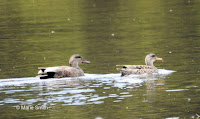GADWALL
GADWALL – (Anas strepera) – (See images below)
DESCRIPTION: The Gadwall is a dabbling duck. As opposed to other duck species, the gadwall drake is not displaying vivid colors. It is grey with striated brown, and has a black rump and tail. Females are similar to mallard females, with striated plumage of two tones of brown. Both sexes have a white wing bar. The bill is dark on top and orange under, and the legs are orange. This species is around 50 cm (18 inches) long.
VOICE: https://www.xeno-canto.org/species/Mareca-strepera
NAME: The English name is of unknown origin, with one hypothesis linking the name to Anglo-Saxon ‘gad’, a ‘point’. This would be in reference to the tooth-like projections along the edge of the bill’s mandible (Choate). The Latin genus name ‘Anas’ stands for ‘duck’, and the Latin species name ‘strepera’ means ‘noisy’.
HABITAT: Small islands in fresh or salt-water marshes or ponds, Prairie Pothole region.
DIET: This duck hunts for insects and arthropods at the bottom of water, sometimes stealing food from diving ducks when those resurface. They feed by upending.
NESTING: The nest is a scrape on the ground, located preferably on islands or near water. Between seven and twelve white eggs are laid, which are incubated by the females. More than one female may lay eggs in the nest. Ducklings soon reach water following hatchling and can search for their own food.
DISTRIBUTION: The breeding range of the gadwall covers inland bodies of water in Canada and the USA, as well as in northern parts of Europe and Asia. It migrates to the southeast USA and Mexico for the winter, also in southern Asia and parts of north Africa. It is a vagrant in Hawaii. (See note below for information on bird vagrancy.)
DISTRIBUTION MAP: https://en.wikipedia.org/wiki/Gadwall#/media/File:Mareca_strepera_map.svg
ON PEI: Gadwalls breed on Prince Edward Island and are fairly common on the island year-round.
CONSERVATION: This bird is among the most hunted ducks but their numbers have actually increased in North America, thanks to sustainable hunting practices and habitat preservation.
Vagrancy: In biology this means an animal going way outside its normal range. For birds, this can happen when there are storms and they get blown off course. On other times, the bird simply wanders in a different direction than usual. Here’s an article about vagrancy in birds.
SIMILAR SPECIES: Mallard (female), American Wigeon (female), Blue-winged Teal (female), Green-winged Teal (female)
REFERENCES: https://www.borealbirds.org/bird/gadwall
https://www.allaboutbirds.org/guide/Gadwall/id
https://www.mba-aom.ca/jsp/toc.jsp (Maritimes Breeding Bird Atlas)
https://identify.whatbird.com/obj/436/_/Gadwall.aspx
https://en.wikipedia.org/wiki/Gadwall
https://www.audubon.org/field-guide/bird/gadwall
http://www.ducks.org/hunting/waterfowl-id/gadwall
DESCRIPTION: The Gadwall is a dabbling duck. As opposed to other duck species, the gadwall drake is not displaying vivid colors. It is grey with striated brown, and has a black rump and tail. Females are similar to mallard females, with striated plumage of two tones of brown. Both sexes have a white wing bar. The bill is dark on top and orange under, and the legs are orange. This species is around 50 cm (18 inches) long.
VOICE: https://www.xeno-canto.org/species/Mareca-strepera
NAME: The English name is of unknown origin, with one hypothesis linking the name to Anglo-Saxon ‘gad’, a ‘point’. This would be in reference to the tooth-like projections along the edge of the bill’s mandible (Choate). The Latin genus name ‘Anas’ stands for ‘duck’, and the Latin species name ‘strepera’ means ‘noisy’.
HABITAT: Small islands in fresh or salt-water marshes or ponds, Prairie Pothole region.
DIET: This duck hunts for insects and arthropods at the bottom of water, sometimes stealing food from diving ducks when those resurface. They feed by upending.
NESTING: The nest is a scrape on the ground, located preferably on islands or near water. Between seven and twelve white eggs are laid, which are incubated by the females. More than one female may lay eggs in the nest. Ducklings soon reach water following hatchling and can search for their own food.
DISTRIBUTION: The breeding range of the gadwall covers inland bodies of water in Canada and the USA, as well as in northern parts of Europe and Asia. It migrates to the southeast USA and Mexico for the winter, also in southern Asia and parts of north Africa. It is a vagrant in Hawaii. (See note below for information on bird vagrancy.)
DISTRIBUTION MAP: https://en.wikipedia.org/wiki/Gadwall#/media/File:Mareca_strepera_map.svg
ON PEI: Gadwalls breed on Prince Edward Island and are fairly common on the island year-round.
CONSERVATION: This bird is among the most hunted ducks but their numbers have actually increased in North America, thanks to sustainable hunting practices and habitat preservation.
Vagrancy: In biology this means an animal going way outside its normal range. For birds, this can happen when there are storms and they get blown off course. On other times, the bird simply wanders in a different direction than usual. Here’s an article about vagrancy in birds.
SIMILAR SPECIES: Mallard (female), American Wigeon (female), Blue-winged Teal (female), Green-winged Teal (female)
REFERENCES: https://www.borealbirds.org/bird/gadwall
https://www.allaboutbirds.org/guide/Gadwall/id
https://www.mba-aom.ca/jsp/toc.jsp (Maritimes Breeding Bird Atlas)
https://identify.whatbird.com/obj/436/_/Gadwall.aspx
https://en.wikipedia.org/wiki/Gadwall
https://www.audubon.org/field-guide/bird/gadwall
http://www.ducks.org/hunting/waterfowl-id/gadwall
 |
| Gadwall pair, PEI, Canada, © Marie Smith |